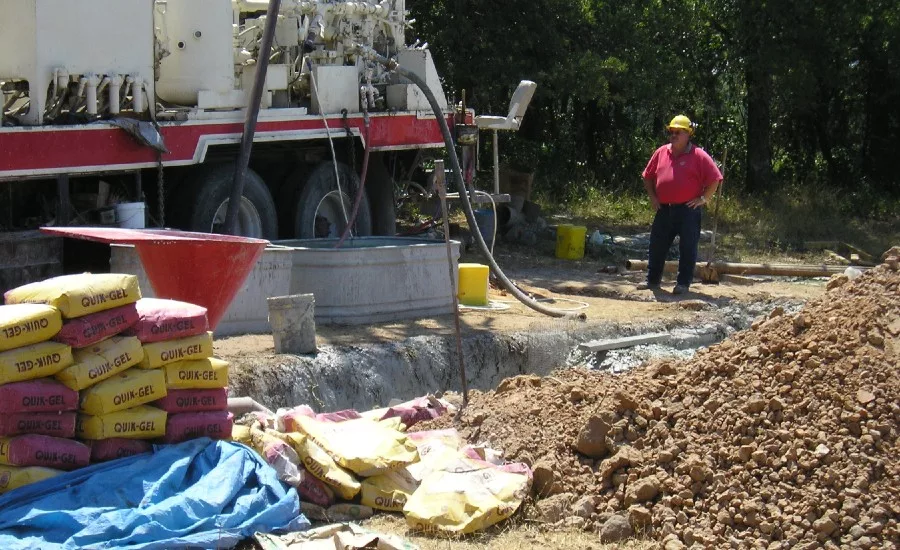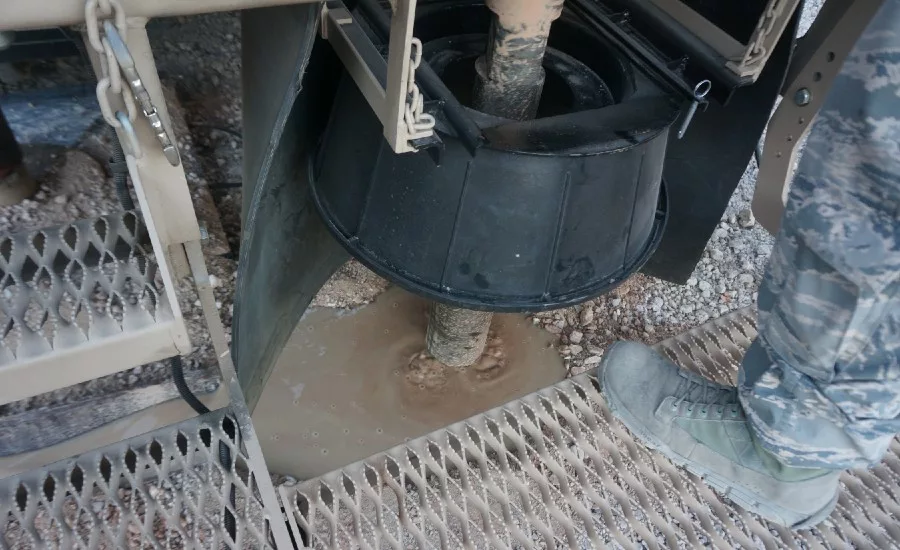What is the Science behind Drilling Fluids?
Drillers Benefit from Understanding Physics of Mud, Uphole Velocity

Getting to success on a well starts with an understanding of the expected geology, and a fluid design to meet that geology and properly carry it out of the hole.
Source: Brock Yordy

Drillers can often overcome inadequate fluids design with more energy and slower drilling rates — as long as they understand the damage done to the borehole.
Source: Brock Yordy

A properly designed fluid dramatically cuts the energy required to get cuttings to the surface.
Source: Brock Yordy
Drilling fluids are one component of the drilling system — a system that requires rotating/cutting action, weight on bit and a competent driller. Drilling fluids are a critical component regardless of water, air, mud, foam or even, today, high-frequency vibration. Fluids are essential to remove drill solids created by the bits.
My idea of creating drilling fluids in mud rotary as a young driller was mixing a bag and a half of gel, throwing in some PAC polymers, and hitting it with long-chain liquid polymer when I couldn’t clean the hole. My family’s business drilled many water wells without any basis in drilling fluids science or physics. Transitioning from a driller to drilling fluids engineer for Baroid IDP opened my eyes to the science of drilling. I had a lot of practical field experience in mud rotary, and I used many products. But after my first few months of training and applying the technical aspects of drilling fluids, I realized what I believed I knew about drilling fluids could have fallen through a 74-micron screen. I know what you are thinking, “Brock, do I need to train for several months with an oil field company to be competent in drilling fluids?” The simple answer is, “No.” You and your team just need to embrace the science and physics of drilling fluids.
What is a Drilling Fluid?
Put simply, a drilling fluid serves as the medium to aid uphole velocity in removing drill solids out of the hole. If you cannot remove the solids, the process becomes an attempt at planting a drill bit to create a steel tree. The driller needs to understand that, based on practical science and physics, drilling fluids cut the energy required to clean the hole. When we utilize air, we need enough energy for an uphole velocity of 3,500 to 7,500 feet per minute in order to remove solids. Using water-based fluids cuts the energy required to remove solids. Now we only require enough energy to create a minimum of 150 feet per minute uphole velocity to do the same solids-removal work.
The massive difference in energy requirements comes from the carrying capacity of air versus water. Drilling fluids decrease the energy required to beat gravity. Think of the drill solids created by the bit as one-inch size astronauts waiting to launch into space. The drilling fluid is the shuttle, and the mud pump or air compressor’s exerted energy is the booster rocket required to break the earth’s gravity. The better rocket we build, the less energy required to move the astronauts out of the hole.
Minimizing the Energy Required
To lessen the energy, we build a drilling fluid. Beyond efficiency, remember that the more energy we exert on a borehole, the greater the opportunity to destabilize and collapse the hole. Air or water alone require the most uphole velocity to carry cuttings out of the hole. To lessen that energy requirement, we alter water or air-fluid systems with designed drilling fluid. When a driller utilizes foam, polymers and light bentonite in air drilling, velocity requirements change from 3,500 fpm to as low as 200 fpm. A driller alters a straight-water system with bentonite, polymers and specialty chemicals to maximize the mud pump’s energy in a mud rotary. Beyond harnessing the right amount of energy, designed drilling fluids stabilize the borehole, minimize impact to fragile formations and maximize rig capabilities.
Building a Flowable Fluid
Once we define the type of fluid and the energy required, the driller can build the right fluid. That process requires an understanding of the solids expected downhole. Remember our space shuttle analogy: The better shuttle we build, the easier it is to get our astronauts out of the hole. The drilling fluid built must aid in suspension and hole stabilization while maintaining upward flow. When we have hole cleaning issues, we try to increase the pump or compressor’s energy. If that does not work, we move to increasing the fluid’s viscosity to aid in the suspension of cuttings while moving upward and out of the hole. Anytime we increase viscosity, we decrease the flowability. Lower flowability means more energy to move the fluid and cuttings. The right drilling fluid balances suspension of drill solids with their ability to flow upward together. Beyond hole cleaning, borehole stabilization is critical to success. Creating the hole and maintaining the hole’s stability to install product and extract resources are two different battles.
Fluid in, the Right Amount of Cuttings Out
Fluid design for stabilization requires two core components: filtration control and inhibition. Filtration control starts with a fluid that can coat the borehole wall to prevent fluids from migrating beyond the desired hole diameter. Most filtration-control additives work best with a bentonite base. Drillers focus our drilling fluid’s energy and velocity up and out of the hole by plugging and coating areas where the fluid could move laterally. Poor filtration control results in an eroded borehole, creating more cuttings, requiring more energy and, ultimately, destabilizing the hole. Once filtration control is regulated, a drilling fluid has to inhibit reactive formations like clays and shales. Long-chain polymers wrap and coat reactive drill solids to prevent them from hydrating. Hydration causes clays to become sticky, swell and break down. When a drilling program allows the clay to become wet, the driller will need to increase rotational torque, while seeing an increase in fluid viscosity and fluid density, and a decrease in hole diameter due to swelling. When we have poor filtration control and inhibition, our ability to clean the borehole diminishes, and drilling issues will continue.
Embracing the Science Lesson
My mentors taught me the best lesson: Drilling fluids are designed to aid in the drilling system. We can often overcome an inadequate fluids design with increased energy and slower drilling rates — as long as we understand the damage done to the borehole. I have worked with some of the best mud mentors globally. They taught me that often a drilling fluid system designed around not more than four products resulted in the best success (while having the advantage of being easily recreated). In air drilling, that meant a two-part foam system augmented with polymers or bentonite. In mud drilling, that design involved a mix of pretreated water and sodium bentonite augmented for filtration control with a low-viscosity PAC and low-weight clay inhibitor — a mud designed with a final viscosity and density that moves up and out easily.
Question Bad Fluid Designs
One harsh lesson taught to me by a mud salesman: It is easy to overcomplicate drilling fluid designs. Beware of a complicated mix design that requires constant changes. Ask whether a more basic design would work. If your mud viscosity is unflowable and the density reaches greater than 9.5 pounds per gallon, time to start over. I often find it easier to dump your entire system and start over than pump surfactants, thinners or torque reducers downhole in hopes that the system will get better.
In the past year, I had to question a lousy fluid design from a mud sales rep who refused to find collaboration in a better way. Again, drilling fluid is one component of the system. If that system has succeeded in the past and now fails, you have the right to question the fluid design. A sound mud engineer will work with you and the system you have onsite. It is way too easy to pull out an app and say that this could never have been drilled this way. It is also essential to understand that simple, single-bag systems are designed for specific formations and parameters. The problem with pre-designed, single-sack fluid is that it is already designed and hard to augment when downhole conditions change.
Get more tips on drilling fluids management
As a driller who then went to work with other drilling system components, I learned the importance of collaboration between all the systems. Working as a mud man taught me a lot about the drilling system and, more importantly, embracing science and physics. Beyond drilling fluids, understanding the importance of the mechanical capabilities of the rig, pumps, air compressor and solids control allowed me to maximize my drilling system. However, the most important lesson learned in drilling is that I, “the driller,” have the greatest influence on success by making good decisions.
Looking for a reprint of this article?
From high-res PDFs to custom plaques, order your copy today!




